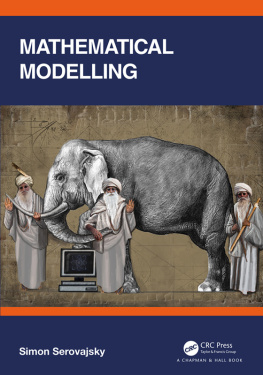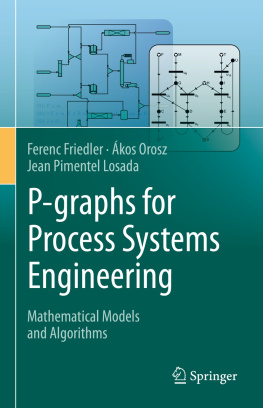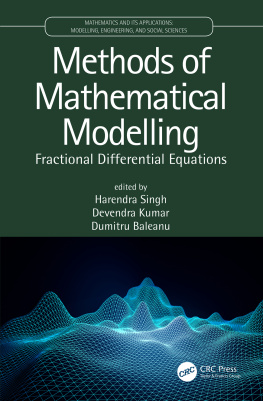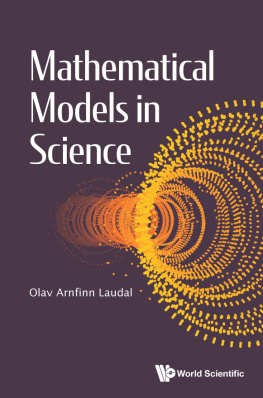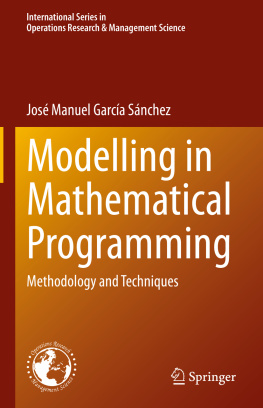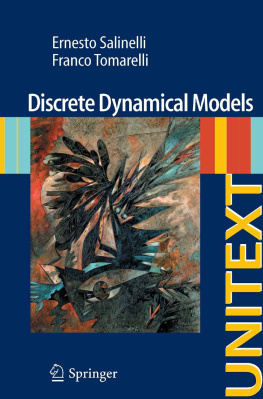Contents
Contents

Mathematical Modelling
First edition published 2022
by CRC Press
6000 Broken Sound Parkway NW, Suite 300, Boca Raton, FL 33487-2742
and by CRC Press
2 Park Square, Milton Park, Abingdon, Oxon, OX14 4RN
2022 Taylor & Francis Group, LLC
CRC Press is an imprint of Taylor & Francis Group, LLC
Reasonable efforts have been made to publish reliable data and information, but the author and publisher cannot assume responsibility for the validity of all materials or the consequences of their use. The authors and publishers have attempted to trace the copyright holders of all material reproduced in this publication and apologize to copyright holders if permission to publish in this form has not been obtained. If any copyright material has not been acknowledged please write and let us know so we may rectify in any future reprint.
Except as permitted under U.S. Copyright Law, no part of this book may be reprinted, reproduced, transmitted, or utilized in any form by any electronic, mechanical, or other means, now known or hereafter invented, including photocopying, microfilming, and recording, or in any information storage or retrieval system, without written permission from the publishers.
For permission to photocopy or use material electronically from this work, access
Trademark notice: Product or corporate names may be trademarks or registered trademarks and are used only for identification and explanation without intent to infringe.
Library of Congress Cataloging-in-Publication Data
ISBN: 9780367474300 (hbk)
ISBN: 9781032147871 (pbk)
ISBN: 9781003035602 (ebk)
DOI: 10.1201/9781003035602
Publisher's note: This book has been prepared from camera-ready copy provided by the authors.
To my comrades in the Problem Laboratory of Mathematical Modelling of the Kazakh University, from where my scientific activity began.
Preface
Mathematics has a special place in human culture. It is radically different from physics, biology, history, psychology, and other sciences. Having abstract concepts as a subject of research such as numbers and functions, equations and sets that are absent in the real world and are a strange product of the human brain, it nevertheless turns out to be surprisingly adapted to comprehend any phenomena of nature and society. The amazing applicability of Mathematics for the analysis of all kinds of events in the surrounding world is due to the presence of an incredible relation between objective reality and the dry abstraction of mathematical constructions. There is a magic bridge that allows us to mysteriously transfer from the usual real world to the fantastic land of Mathematics and come back after a fascinating journey through its endless expanses with the accumulated baggage of knowledge. This mysterious bridge is mathematical modelling, which is a specific form of cognition of the surrounding world, capable of translating the laws of nature studied by individual sciences into mathematical language, and then seeing real life events behind dispassionate mathematical formulas.
The subject of this book is mathematical modelling. The author did not set himself the goal to either teach the reader some individual laws of nature and society, or acquaint them with mathematical methods to solve applied problems. Our aim is to learn how to build bridges between Mathematics and the outside world. We want to show how completely different natural phenomena can be described mathematically using the same techniques. Here both strict mechanics, thoroughly saturated with mathematical ideas, and shaky psychology, seemingly not at all amenable to formalization, find themselves in an equal position.
The choice of research objects remains entirely on the author's conscience. The breadth of the covered of the subject determined the relatively shallow depth of its study from the standpoint of both mathematics and special sciences. There are multivolume respected books devoted to the application of mathematical methods for the analysis of processes exclusively related to the field of a particular science activity, or even its small section. If any of the serious readers is interested in mathematical economics or mathematical ecology, not to mention mathematical physics, then they are advised not to waste their invaluable time studying this modest book, but refer to the relevant literature.
The book consists of an introduction and four parts. The introduction, which is the subject of the first chapter, discusses the general principles of mathematical modelling. The first part, consisting of eight chapters, is devoted to lumped-parameter systems. It deals with dynamical systems described by ordinary differential equations and related to physics, chemistry, biology, economics and social sciences. For a better perception of the material and the performance of the tasks given here, basic information is also given on the methods of qualitative and quantitative analysis of such systems. The second part, consisting of six chapters, examines distributed-parameter systems described by partial differential equations with various practical interpretations. The third part is devoted to other types of models. In particular, variational principles, discrete systems and stochastic systems related to various subject areas are studied here. The final part contains additional material, particularly, mathematical problems related to the considered models, optimal control problems and identification of mathematical models.
It should be noted that although each chapter has a self-sufficient subject, the materials of different chapters are rather closely intertwined. On the one hand, the same mathematical models can have qualitatively different interpretations. For example, the same equations describe the coexistence of different biological species on the same territory, and the competition of firms in the free market, and the struggle of political parties for votes. The model describing the heat distribution also characterizes the processes of diffusion and electrical conductivity, as well as the a biological species migration, the epidemic spread and commercial activity in a certain area. On the other hand, a specific process under certain conditions can be described qualitatively in different ways. For instance, a continuous model based on ordinary differential equations or a discrete model based on difference equations can be used to describe the evolution of a biological species. If the species migrates over a territory, then partial differential equations should be used to describe this process. If the process is influenced by some random factors, then stochastic models should be used. For describing the body movement, one can use both the equations of motion and variational principles.
Each chapter of the book includes several levels. First of all, it is a lecture which contains the main material of this chapter. Those who want to get only a general idea of the subject under discussion can limit themselves to this, boldly ignoring all the rest of the material. This is followed by an appendix, which provides additional information to allow the reader to broaden their understanding of the subject of the study. In addition, there are notes that perform several functions at once. It provides a literature review on the discussed issue. It reveals the serious connections of the considered subject with the results of other chapters, which increases the integrity of the book subject. Some remarks are made there, allowing a deeper understanding of the material under consideration. Some mathematical transformations from the lecture and the appendix are also taken there. This facilitates the perception of the material for the reader who does not want to go deeply into technical details, but provides such an opportunity for the interested reader. Thus, to some extent, it is possible to maintain a balance between material availability and mathematical rigor. Finally, in the course of the lecture and the appendix, tasks are given with the necessary methodological instructions. They can be used as assignments for independent work of students, as well as for individual readers engaged in self-education.

